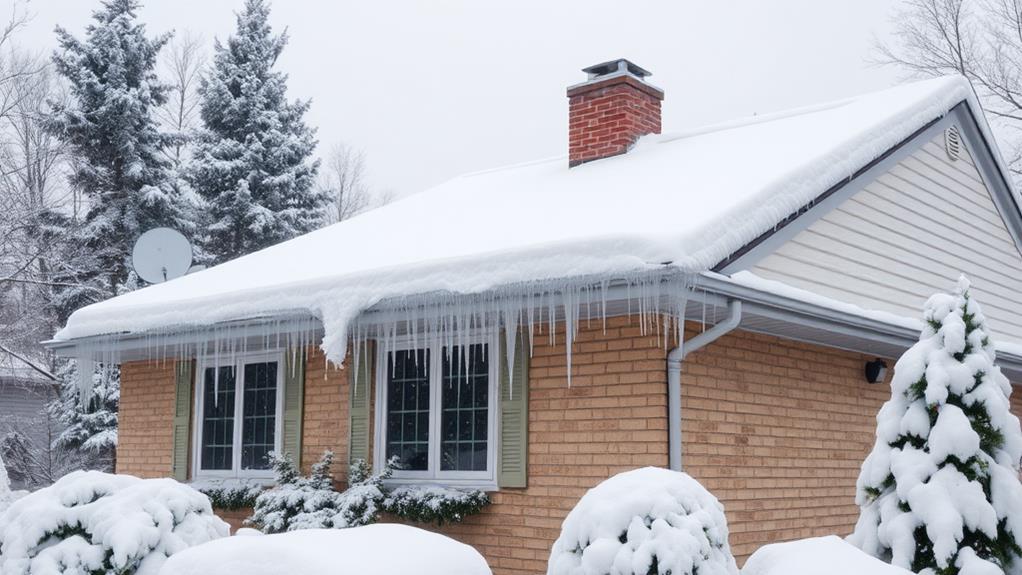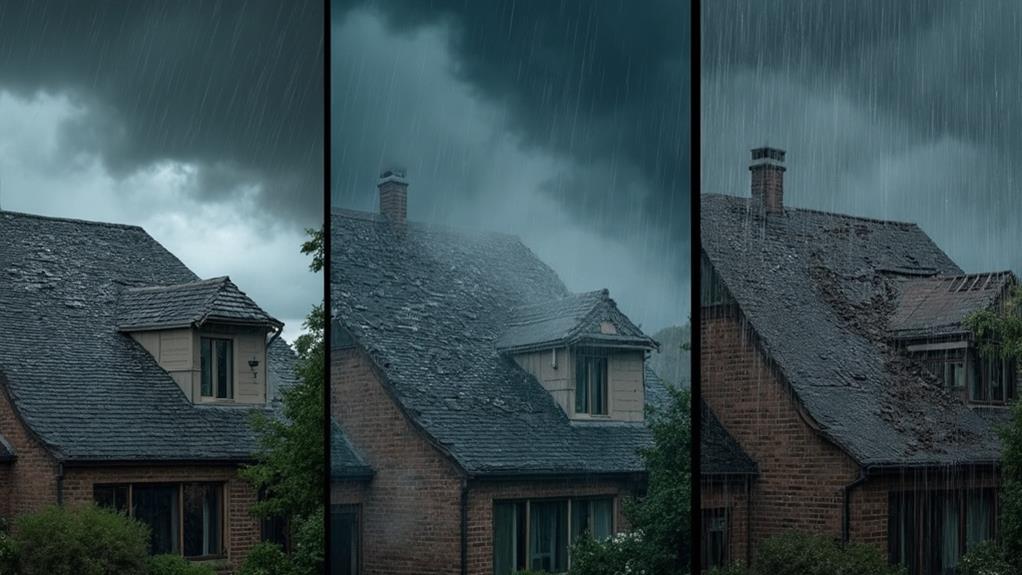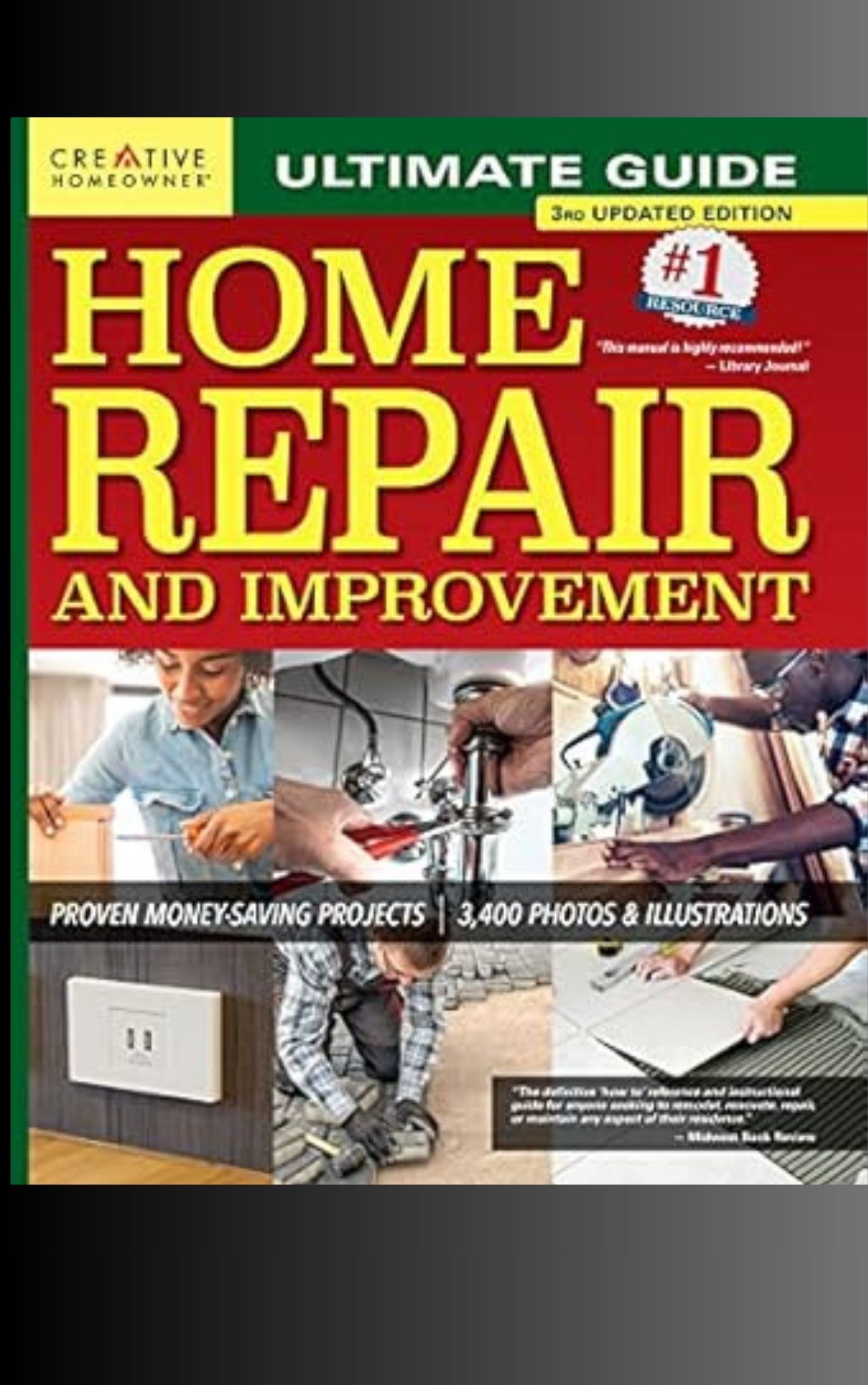Different storms pose unique threats to your roof. Thunderstorms bring heavy rain and wind, potentially causing leaks and lifting shingles. Hailstorms can crack or dent roofing materials, compromising their protective qualities. Snowstorms and blizzards accumulate heavy loads, risking structural damage and ice dams. Hurricanes and tropical storms combine high winds, intense rainfall, and debris impact, potentially tearing off roofing materials. Tornadoes exert extreme forces that can destroy entire roof structures. Even prolonged sun exposure accelerates aging and weakens materials. Understanding these distinct risks is crucial for maintaining your roof's integrity and longevity. Exploring each storm type in detail reveals essential protection strategies.
Thunderstorms and Heavy Rain

Thunderstorms and heavy rain unleash a barrage of potential threats to your roof's integrity. These weather events can cause immediate damage and accelerate long-term wear, compromising your home's protective barrier.
Heavy rainfall tests your roof's water-shedding capabilities, exposing weak points in flashing, shingles, or overall drainage design. As water accumulates, it can seep beneath shingles, leading to leaks and interior water damage. Prolonged exposure to moisture promotes the growth of mold and mildew, which can deteriorate roofing materials and pose health risks.
Strong winds accompanying thunderstorms may lift or dislodge shingles, creating entry points for water and increasing the risk of further damage. Lightning strikes, though rare, can cause catastrophic damage to your roof and home's electrical system. Even nearby strikes can induce power surges that may affect rooftop equipment like satellite dishes or solar panels.
Hail, often associated with severe thunderstorms, can crack, chip, or loosen shingles, reducing their effectiveness and lifespan. Regular roof inspections and maintenance, especially after significant storms, are crucial for identifying and addressing these potential issues before they escalate into costly repairs.
Hailstorms
Hailstorms frequently pose a unique and severe threat to roof integrity. These intense weather events can cause significant damage to roofing materials, often resulting in costly repairs or even full replacements. Hailstones, which vary in size from pea-sized to softball-sized, can create divots, cracks, and punctures in shingles, tiles, and other roofing components.
The severity of hail damage depends on factors such as hailstone size, wind speed, and roof material. Asphalt shingles are particularly vulnerable, with hail impacts potentially dislodging protective granules and exposing the underlying matting. Metal roofs, while more resistant, can still suffer dents and scratches that compromise their protective coating.
Clay or concrete tiles may crack or shatter under the force of large hailstones. Even if damage isn't immediately visible, hailstorms can weaken a roof's structural integrity, leading to leaks and other issues over time. After a hailstorm, it's crucial to have a professional inspection to identify and address any damage promptly. This proactive approach can prevent more extensive and expensive problems in the future, ensuring the longevity and effectiveness of your roof.
Snowstorms and Blizzards

While hailstorms strike with sudden force, snowstorms and blizzards present a different set of challenges for roofs. These winter weather events can accumulate heavy loads of snow and ice, potentially overwhelming a roof's structural integrity. The primary concern is the weight of snow, which can reach up to 20 pounds per cubic foot for wet, heavy snow. This excessive load can cause roof sagging, leaks, or even collapse in severe cases.
Blizzards compound these issues with high winds, driving snow into roof vents, exhaust pipes, and other openings. This infiltration can lead to moisture damage within the attic space. Additionally, the freeze-thaw cycle during and after snowstorms can create ice dams along the roof's edge. These dams prevent proper drainage, forcing melted snow to back up under shingles and potentially into the home's interior.
To mitigate these risks, regular roof maintenance is crucial. This includes ensuring proper insulation and ventilation to prevent ice dam formation, reinforcing weak areas, and promptly removing excessive snow accumulation. Homeowners should also be vigilant for signs of stress, such as creaking sounds or visible sagging, during heavy snowfall events.
Hurricanes and Tropical Storms
Unlike other storm types, hurricanes and tropical storms pose a unique and multifaceted threat to roofs due to their prolonged duration and combination of high winds, heavy rainfall, and potential debris impact.
The sustained high winds, often exceeding 74 mph in hurricanes, can lift and tear off shingles, tiles, or entire sections of roofing material. This exposes the underlying structure to water damage and further wind erosion.
The intense rainfall accompanying these storms can quickly overwhelm gutters and drainage systems, leading to water ponding on flat roofs or seeping under damaged areas. This heightens the risk of leaks and structural damage.
Additionally, hurricanes and tropical storms can turn everyday objects into projectiles, causing punctures or severe impact damage to roofs.
The cyclical nature of hurricane winds can create pressure differentials that stress roofing systems from both above and below. This can result in roof uplift, particularly in areas with poor attic ventilation.
To mitigate these risks, homeowners in hurricane-prone regions should invest in impact-resistant roofing materials, reinforced roof decking, and proper attic ventilation to equalize pressure during storms.
Tornadoes

Tornadoes represent an extreme threat to roofs due to their intense, localized winds and destructive power. These violent rotating columns of air can produce wind speeds exceeding 300 mph, creating a formidable force capable of devastating entire structures. Roofs are particularly vulnerable to tornado damage due to their exposed position and the upward suction generated by the storm's vortex.
The primary risks to roofs during a tornado include:
- Uplift: The intense low pressure inside the tornado can create a powerful lifting force, potentially tearing the roof off entirely.
- Debris impact: Flying objects propelled by high winds can puncture or severely damage roofing materials.
- Pressure differentials: Rapid changes in air pressure can cause roofs to explode outward.
- Structural stress: The twisting motion of tornado winds can compromise the integrity of the roof's supporting structure.
To mitigate tornado damage, homeowners should ensure proper roof installation, including adequate fastening and bracing. Regular maintenance and inspections can identify weak points before a storm hits. Additionally, impact-resistant roofing materials and reinforced roof-to-wall connections can enhance a roof's resilience against tornado forces.
Extreme Heat and Sun Exposure
Scorching temperatures and relentless sun exposure can wreak havoc on roofing systems over time. The intense heat causes materials to expand and contract repeatedly, leading to weakened structural integrity. Asphalt shingles are particularly vulnerable, as prolonged exposure to UV rays breaks down their protective granules, causing them to curl, crack, or blister.
The sun's ultraviolet radiation also accelerates the aging process of roofing materials, causing them to become brittle and lose their flexibility. This deterioration can result in leaks, reduced energy efficiency, and decreased overall lifespan of the roof. Dark-colored roofs absorb more heat, exacerbating these issues and potentially increasing cooling costs for the building.
Extreme heat can also cause the attic space to become superheated, which can lead to moisture buildup and potential mold growth. Proper ventilation is crucial to mitigate this risk. Additionally, high temperatures can soften the adhesive used in roofing installations, potentially compromising the roof's ability to withstand wind uplift during storms. Regular inspections and maintenance are essential to identify and address heat-related damage before it escalates into more severe roofing issues.
Frequently Asked Questions
How Often Should I Have My Roof Professionally Inspected?
Professional roof inspections are recommended annually, or biannually for older roofs. However, additional inspections may be necessary after severe weather events or if you notice any signs of damage or leaks. Regular inspections help maintain roof integrity and longevity.
Can Storm Damage Void My Roof Warranty?
Like a ticking time bomb, storm damage can indeed void your roof warranty. Manufacturers typically exclude damage caused by extreme weather events. However, proper maintenance and prompt repairs following storms can help preserve your warranty's validity and protect your investment.
What's the Best Roofing Material for Areas Prone to Multiple Storm Types?
For areas prone to multiple storm types, impact-resistant asphalt shingles or metal roofing are excellent choices. These materials offer durability against various weather conditions, including high winds, hail, and heavy rainfall, while providing long-lasting protection for your home.
How Can I Prepare My Roof for an Upcoming Storm Season?
Like a knight donning armor for battle, preparing your roof for storm season involves inspecting shingles, cleaning gutters, trimming overhanging branches, reinforcing weak spots, and ensuring proper attic ventilation. Consider professional assessment for comprehensive protection against nature's onslaught.
Are There Any Storm-Resistant Roofing Technologies Available for Residential Homes?
Yes, several storm-resistant roofing technologies are available for residential homes. These include impact-resistant shingles, metal roofing systems, concrete tiles, and synthetic slate. Additionally, advanced underlayments and proper installation techniques can significantly enhance a roof's storm resistance.
Conclusion
Different storm types pose unique challenges to roof integrity. While some may argue that all severe weather events are equally damaging, each storm category impacts roofing materials differently. Thunderstorms primarily cause water damage, hailstorms inflict impact damage, and snowstorms create weight-related issues. Hurricanes combine multiple threats, while tornadoes can cause catastrophic destruction. Even prolonged sun exposure degrades roofing materials over time. Understanding these distinctions enables property owners to better prepare for and mitigate potential roof damage from various weather events.

